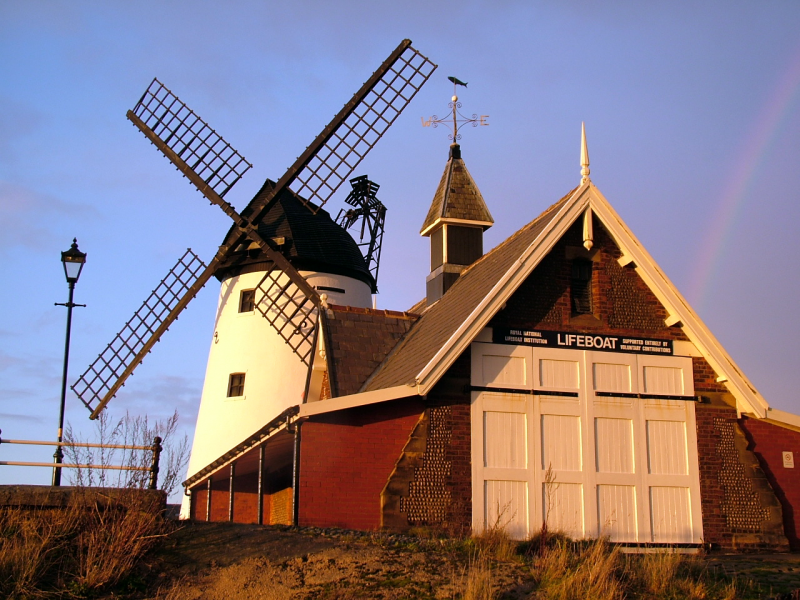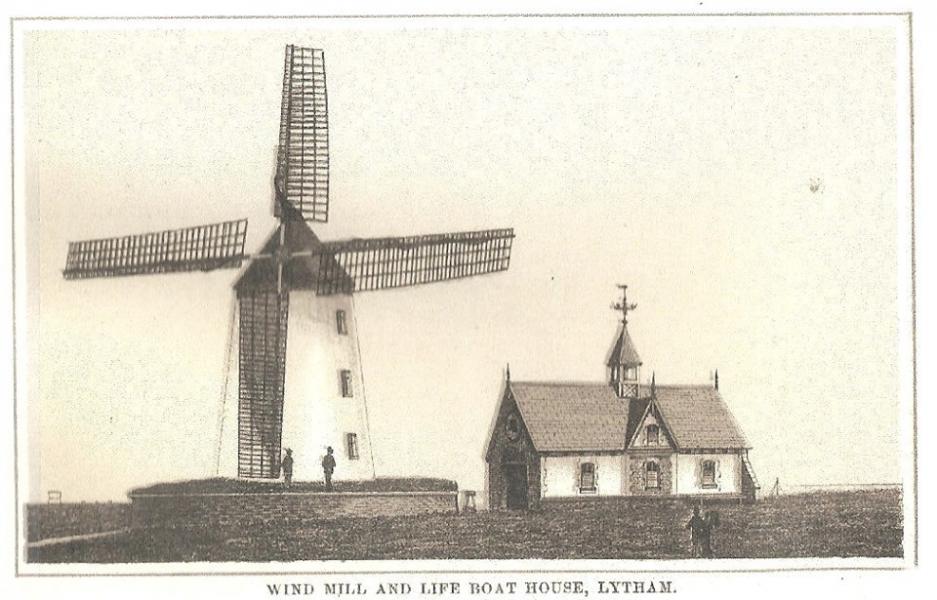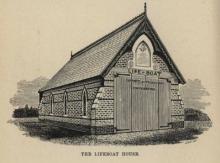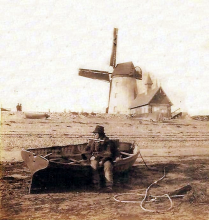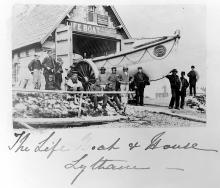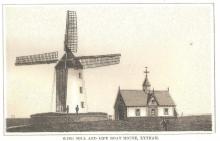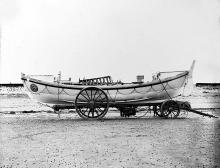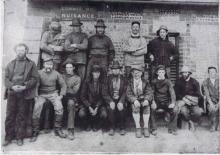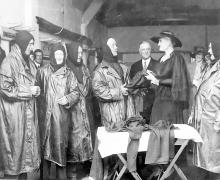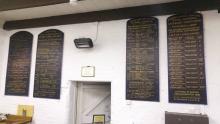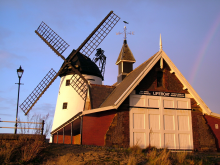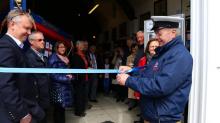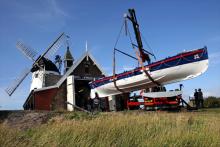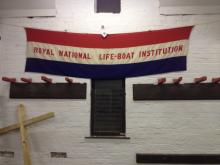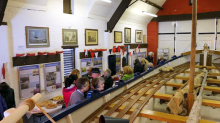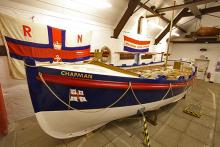Traditionally local fishermen had assisted shipwrecked sailors in the Ribble Estuary. In later years steam tugs from Lytham Docks also assisted with ship wrecks, until in 1849 when they ceased to be available.
During 1850 a series of shipwrecks occurred in the estuary with sad loss of life. As a result in 1851 local, John Hayes approached the RNIPLS (Royal National Institution for the Preservation of Life from Shipwreck) to request a lifeboat station at Lytham. The RNIPLS being short of funds offered to pay half of the cost of the lifeboat.
A local appeal was set up and £200 was quickly raised, with a significant initial donation from the Squire, John Talbot Clifton. Much of the money coming from visitors and holidaymakers to the area.
In August 1851 as the RNIPLS were struggling for funds the SFMBS (the Shipwrecked Fishermen and Mariners Benevolent Society) agreed to supply a lifeboat with the funds raised.
The boat was built by James Beeching at Great Yarmouth to the new self-righting design capable of being rowed and sailed. After initial tests at Liverpool the new lifeboat was sailed to Lytham in early December 1851. The vessel was pulled by eight oars with 4 men each side. The crew consisted of a total of 11, with Coxswain, 2nd Coxswain, Bowman and oarsmen. The 28 feet long by 7 feet beam vessel was named The Clifton after Squire’s original donation. As she arrived before a shelter was built she was initially stored on the beach.
The Squire also donated the money and the land to build the new boat house for The Clifton. This fine new building was built immediately to the east of the Windmill on the site of the old brick kiln and was completed in 1852. John Edmondson was appointed Honorary Secretary in charge of the station. The Coxswain of the lifeboat was Ribble pilot William Swann, his deputy was fisherman John Davies. The boathouse also contained a small lighthouse on its roof powered by gas from a connection to the town’s new mains gas system. The gas was provided for free by the Lytham Improvement Commission and the supply was put in by the Ribble Navigation Company.
The first lifeboat building is often confused with the drying kiln, positioned just to the north of the mill used for drying the wheat before grinding. This was pulled down in the same year and moved to Wharfe Street. In 1881 the kiln was again moved to East Cliffe.
Other than regular exercises the crew were not to see any significant callouts during 1852. On the 1 October of that year the Clifton went at out at 1pm to collect the Coxswain from a schooner bound for Preston. They left one of the crew on the schooner as a pilot and sailed off with a crew of ten men. Swann was keen to try out the vessel in the strong squally west north westerly winds. So he left her with too much sail to see how she would behave. Unfortunately she was suddenly hit by a large squall and the vessel broached causing her to completely invert. Five of the crew were thrown clear but quickly drowned having taken no lifebelts for the trip. The remaining crew remained under the capsized vessel which did not self-right, using the vents for clearing the water from the decks as invaluable airways. Swann tried to swim out and re-right the boat but was not seen alive again. One by one the remaining crew started to succumbed to the cold. After the squall had passed it was noticed from shore that the vessel had inverted and two boats of rescuers went to assist. Finally the rescuers arrived but after three hours in the water only Richard Gillett and James Parkinson were still alive. They were landed at Lytham at 7pm that evening. This tragic event left eight widows and 27 children, the two survivors being the only single men of the crew.
Despite the horrendous set back the Clifton was not shunned by the lifeboat crew and was quickly put back into action a few months later. In a short period of 3 years the boat saw 9 services and saved 8 lives. In December 1854 the station was handed over to the newly formed RNLI to become the Institution’s first North West station.
In August 1855 the lifeboat was replaced by the slightly larger, Forrestt built, ten oared, Eleanor Cecily named after John Talbot’s wife. After saving eighty lives in a period of 8 years this active vessel was again replaced in July 1863 by the even larger 33ft by 8ft, ten oared Wakefield. To house the new lifeboat the lifeboat house was completely rebuilt in the same year immediately to the south of the windmill. This new extended building was originally built without the side shelters. These were added firstly to the east in January 1889 and then to the west in May that year. In 1878 the Wakefield was renamed the Charles Biggs. In 1886 the Charles Biggs was replaced by a new Charles Biggs. In 1912 this was replaced by the Kate Walker.
The building was kept in continuous use until 1931 with the arrival of the JHW. This heavier motorised lifeboat saw the end of the era of pulling and sailing lifeboats and was kept on moorings off Lytham Pier head and the lifeboat house was reduced to storage use. The Old Lifeboat House as it has become known, was sold by the RNLI in 1960 and was occasionally used as a store until it was bought by Fylde Borough Council in 1985. The following year the building was opened as a Lifeboat Museum. This museum remained open for over 18 years until 2004.
In the period since the building has unfortunately remained empty. In August 2015 the building was again reopened as a Lifeboat Museum by Lytham Heritage Group working closely with some of the original lifeboat museum team and Fylde Borough Council.
Old Lifeboat House
Lytham’s very first Lifeboat House was built in 1852 by Squire John Talbot Clifton and was sited just to the east of the windmill, where the old corn-drying kiln had stood. It was demolished when, in 1863, today’s Old Lifeboat House was erected south of the mill, at a cost of £160.10. This cobble and brick building, in the local decorative vernacular style, has a tall steeply pitched roof, decorative finials, dormers and barge boards. Either side of it are benches sheltered by a roof supported by cast iron columns, but these were not added until 1900.
The boathouse is aligned with the slipway and has large double doors to the seaward end. It housed lifeboats until 1931 when the lifeboat had to be moved to new moorings off Central Beach due to the silting up of the River Ribble. It was then used for storing boats and equipment until 1960 when it became a private boat store until the Civic Society exhibition of 1975. It is now owned by Fylde Borough Council and houses a permanent exhibition of lifeboat memorabilia.
For many years since World War II, the lifeboat was anchored in the estuary off Seafield Road. Owing to increased silting up, it is now housed in a handsome new Lifeboat House at St Annes (until 1925, St Annes had its own Lifeboat, housed in what is now a funeral parlour in Eastbank Road). The in-shore boat is still kept at Lytham, in the Lifeboat House at the end of the jetty.
from "The listed buildings of Lytham St. Annes" - Lytham St. Annes Civic Society 2003
Bibliography
"On those infernal Ribble banks" by David Forshaw - a record of Lytham St. Annes lifeboats. Available at the Heritage Centre and RNLI shop.
If you have additional information or pictures that may usefully added to this page then please get in touch with us.
